| کد مقاله | کد نشریه | سال انتشار | مقاله انگلیسی | نسخه تمام متن |
|---|---|---|---|---|
| 6270987 | 1614750 | 2016 | 9 صفحه PDF | دانلود رایگان |
- Brain signal complexity rises over visual areas during learning of faces.
- Repetition suppression is simultaneous to the rise in complexity during learning.
- The rise in signal complexity is more pronounced over right occipito-temporal area.
- The rise in complexity over visual areas is modulated by prefrontal tDCS.
Neuronal activity associated with visual processing of an unfamiliar face gradually diminishes when it is viewed repeatedly. This process, known as repetition suppression (RS), is involved in the acquisition of familiarity. Current models suggest that RS results from interactions between visual information processing areas located in the occipito-temporal cortex and higher order areas, such as the dorsolateral prefrontal cortex (DLPFC). Brain signal complexity, which reflects information dynamics of cortical networks, has been shown to increase as unfamiliar faces become familiar. However, the complementarity of RS and increases in brain signal complexity have yet to be demonstrated within the same measurements. We hypothesized that RS and brain signal complexity increase occur simultaneously during learning of unfamiliar faces. Further, we expected alteration of DLPFC function by transcranial direct current stimulation (tDCS) to modulate RS and brain signal complexity over the occipito-temporal cortex. Participants underwent three tDCS conditions in random order: right anodal/left cathodal, right cathodal/left anodal and sham. Following tDCS, participants learned unfamiliar faces, while an electroencephalogram (EEG) was recorded. Results revealed RS over occipito-temporal electrode sites during learning, reflected by a decrease in signal energy, a measure of amplitude. Simultaneously, as signal energy decreased, brain signal complexity, as estimated with multiscale entropy (MSE), increased. In addition, prefrontal tDCS modulated brain signal complexity over the right occipito-temporal cortex during the first presentation of faces. These results suggest that although RS may reflect a brain mechanism essential to learning, complementary processes reflected by increases in brain signal complexity, may be instrumental in the acquisition of novel visual information. Such processes likely involve long-range coordinated activity between prefrontal and lower order visual areas.
Journal: Neuroscience - Volume 326, 21 June 2016, Pages 1-9
